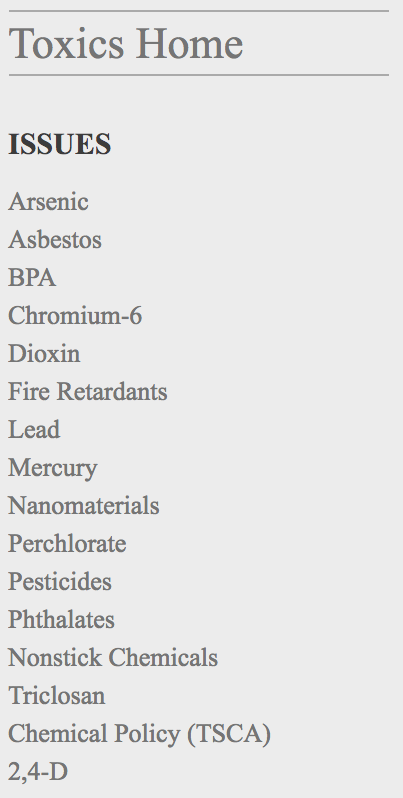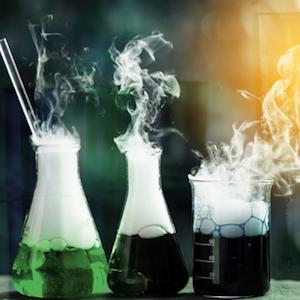The Environmental Working Group (EWG) uses an authoritative sounding name to peddle scientific half-truths and outright fabrications. Along with Greenpeace and PETA, it is beloved by activists but detested by scientists.
Several years ago, George Mason University surveyed 937 members of the Society of Toxicology, an association of professional toxicologists. Nearly 4 out of 5 (79%) of those responding said that EWG -- as well as the Natural Resources Defense Council (NRDC) and Center for Science in the Public Interest (CSPI) -- overstate the health risks of chemicals.
Despite this vote of no confidence in EWG by the scientific community, the organization manages to scare enough people to operate a $12.5-million budget. Telling people that unseen dangers lurk in their food and inside their homes is a lucrative business.
 EWG's List of Scary Chemicals
EWG's List of Scary Chemicals
Chemicals. It's a word used mainly by the scientifically naïve to mean "scary things." EWG takes this illiteracy a step further by referring to them as Toxics. On the right is a screenshot of the current list of "Toxics" that has the EWG riled up. Let's debunk them one by one.
Arsenic. This is a naturally occurring chemical element. It accumulates in food like rice, but Americans are not exposed to worrisome amounts of arsenic in their diets.
Asbestos. By now, everybody is aware of the danger of asbestos. Because of its link to mesothelioma, asbestos has been banned from various products and applications. So, why is EWG still raising money on it?
BPA. The FDA says that BPA is safe, so your endocrines aren't being disrupted, but the EWG rejects the scientific consensus. Besides, if manufacturers replace BPA (which helps prevent food spoilage) with another chemical, there's a good chance the substitute will be even worse than BPA.
Chromium-6. Hexavalent chromium skyrocketed to fame because of the thoroughly unscientific movie Erin Brockovich. Inhaling it can cause cancer, but ingesting it (from drinking water, for example) probably does not.
Dioxin. There are more than 400 chemicals that could be called "dioxin" or "dioxin-like," so it's unclear which one(s) EWG is complaining about. One of the dioxin molecules, called 2,3,7,8-TCDD was a contaminant found in Agent Orange, an herbicide and defoliant manufactured at the request of the U.S. government. 2,3,7,8-TCDD has no known commercial applications. According to the WHO, because dioxins are everywhere, nearly all humans have trace amounts of them in their bodies, but they are not thought to affect human health.
Fire retardants. Furniture contains fire retardants to prevent your house from burning down. The EWG would prefer that we all suffer an increased risk of dying in a fire in order to eliminate a completely theoretical (and unlikely) risk from fire retardants.
Lead. Everybody agrees that lead is bad. Why is the EWG still raising money on it?
Mercury. The EWG misleadingly states, "Mercury exposure from eating fish carries serious health risks." No, mercury from certain types of fish can carry a health risk. Most fish is perfectly healthy. The FDA has published a handy chart, depicting which fish we should eat and which we should avoid. The EWG, of course, distorts this information. For example, EWG says that pregnant women "should limit or avoid" canned light tuna. The FDA disagrees, saying that pregnant women can safely eat 2 to 3 servings per week.
Nanomaterials. This is like saying "chemicals." Such a vague term is meant to sow confusion, not clarify it.
Nonstick materials. The EWG is conducting a war on Teflon and other nonstick materials. They don't like the molecule perfluorooctanoic acid, which is possibly toxic and used to make Teflon. But the final product doesn't contain PFOA; instead, the final product is a polymer, and it bears no resemblance to PFOA. The American Cancer Society says that PFOA could possibly be unhealthy, but Teflon is not. The same will be true of other polymers and the PFCs (polyfluorinated compounds) from which they are derived.
Perchlorate. The EWG misleadingly calls perchlorate a component of "rocket fuel." Yes, it is used in rocket fuel, but it's also a perfectly natural compound found in arid soil and the atmosphere. The FDA recommends that drinking water contain less than 15 ppb perchlorate, and it also says that a study showed that people's perchlorate consumption was less than the current EPA reference dose (i.e., the maximum acceptable oral dose). The EPA will set additional guidelines by the end of October 2018.
Pesticides. Both conventional and organic pesticides are safe, as long as they are applied at or below approved levels.
Phthalates. Phthalates are used to make flexible tubes. Like BPA, they won't disrupt your endocrines.
Triclosan. The EWG is right to be opposed to triclosan but for the wrong reasons. Once again, EWG is worried about your endocrines being disrupted. That's nonsense. Antibacterial soap, which contains triclosan, confers no added benefit over regular soap. Also, triclosan might exacerbate antibiotic resistance. So, it's a good thing that the FDA banned triclosan from soap.
2,4-D. 2,4-D is a perfectly safe herbicide. You can buy it at Home Depot.
Overall, through exaggeration or fabrication, the EWG gets pretty much everything wrong. On the few topics it gets right, the government has already acted, so EWG is just beating a dead horse to raise money.




